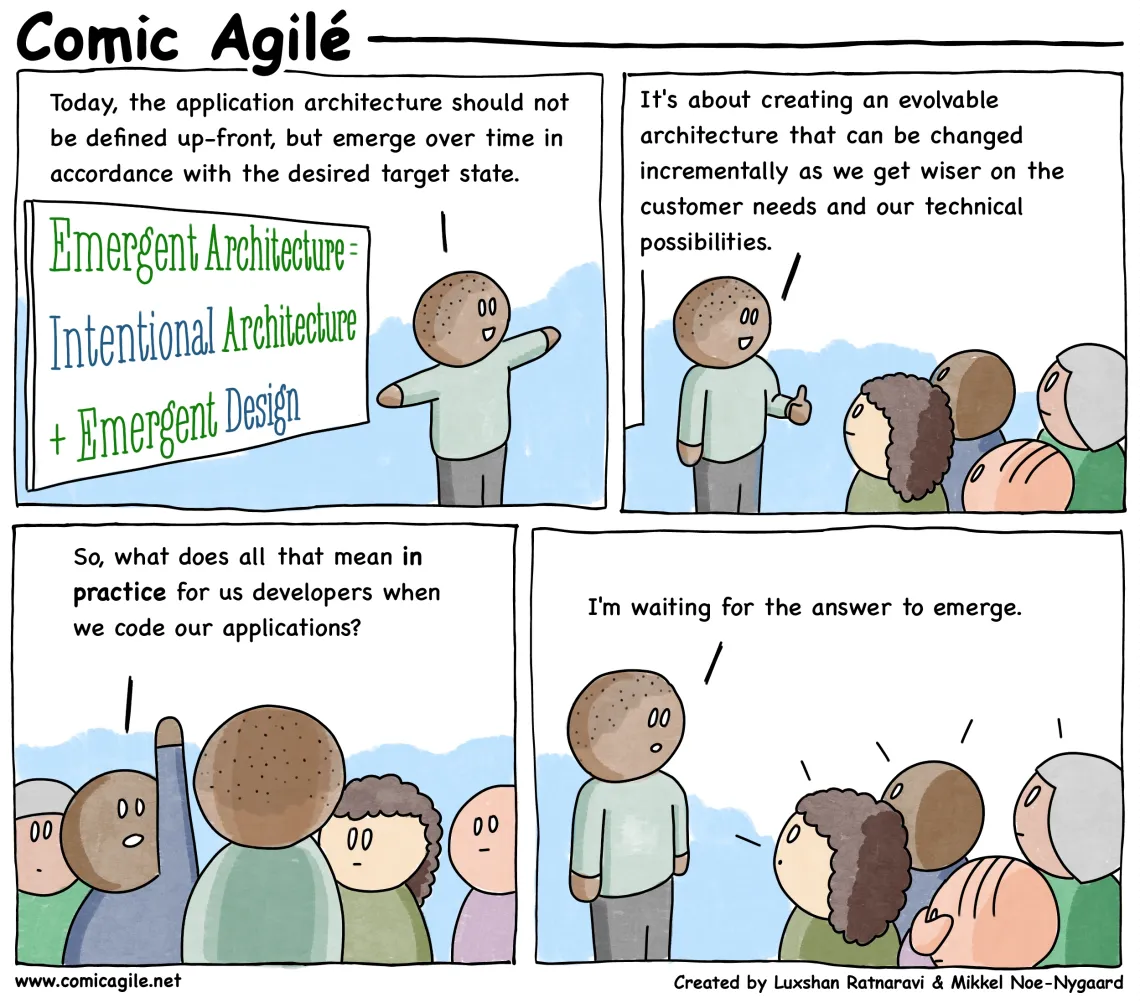The Dynamics of Emerging Architecture in Agile Organizations
Simple organizations, especially those who are in a startup phase, are usually characterized by a small number of people, who are able to cover multiple roles and functions, and where the communication is direct and informal.
The design of the overall architecture of the systems, applications and services consisting the organization is usually the result of a single vision, which is often the result of the founder’s experience and knowledge, and the result of the first implementations of the organization: these are usually easy to change, adapt, and evolve, since they are owned by a single person or a single team.
In such a scenario, the enterprise architecture is usually not a concern, since the organization is still small and the systems are not yet complex enough to require a dedicated function, the technological stack is usually homogeneous and the communication between the different components is direct and simple.
Moving to the Next Level

When the organization starts to grow, the number of people involved in the development of the systems increases, and the number of systems and applications increases, the complexity of the overall architecture increases, and the need for a dedicated function to manage it becomes more and more evident.
To such a complexity and growth pain, it is usually added the need to maintain the existing systems, which are usually not designed to be easily changed, since they were typically implemented to serve an immediate need, and not to be part of a long-term strategy: such systems are usually called legacy systems, and they are usually the most difficult to change, since they are the result of a legacy architecture.
In several situations, I found myself approaching the source code of some of these applications, to trying make sense of the design choices, and I found myself wondering ‘what were they thinking?’. In fact, the design of such systems is usually the result of a design by committee approach, where the different stakeholders of the organization, with different backgrounds, knowledge and objectives, have contributed to the design of the system, without a clear vision and strategy. In addition to this, it is typical that the most senior technical figures who led the design of such systems had no training in the best practices of software design, and they were usually the most senior developers, who were promoted to the role of technical lead or architect.
Anyway, organizations who grow face new problems and challenges, often underestimated and not considered in the initial design of the systems, and they are forced to adapt and evolve the architecture of their systems, to make them more resilient, scalable, maintainable and secure.
For example, a growth in the number of users of a system might require to scale the system horizontally, to increase the number of instances of the application, to serve the increased number of requests, or to scale the system vertically, to increase the capacity of the existing instances, to serve the increased number of requests, or to acquire services from external providers, terminating some functions currently implemented in the system.
The Emergence of Architectures
The evolution of the architecture of the systems of an organization is usually the result of a series of emergent designs, which are the result of the emergent behaviors of the organization, and not of a single architectural vision.
As much as one might want to academically state that the architecture of an enterprise can be clearly defined and designed, the reality is that the architecture of an organization is the result of the emergent behaviors of the organization itself: choices are taken by decentralized teams, with the ambitions of solving the problems they are facing, and not of designing the overall architecture of the organization.
These dynamics within the organization are usually the result of the Conway’s Law, which states that
‘Organizations which design systems […] are constrained to produce designs which are copies of the communication structures of these organizations’
Such a dynamic is particularly observable in Agile organizations, where the teams are self-organized and autonomous, and they are not constrained by a centralized architecture function, producing a multitude of services and applications which implement each one a specific set of patterns and practices, reflecting the skills and knowledge of the team who designed and implemented them, rather than a coherent and consistent architecture.
Enterprise Architects who belong to such organizations should resist the impulse to rationalize and operate any military force to restrain such movements, frustrating the values and mission of the organization, that intentionally has chosen such technical paths, but rather try to make sense of the emergent architecture, trying to identify the patterns and the commonalities between the different systems, and trying to identify the best practices and the standards to be applied to the different systems.
I never found it productive trying to impose a top-down approach to the design of the architecture of an organization, going against the existing asset of people, skills and systems, but rather trying to influence them, by providing the teams with the right tools, standards and best practices, to make them more effective and efficient, communicative and collaborative.
Mixing Intentional and Emergent Architectures

As mentioned above, successful organizations grow and evolve, and with them the enterprise architecture of the systems they are composed of: this means that large portions of the functions implemented internally (eg. CRM, ERP, communications, etc.) are usually replaced by external services, externalizing costs, risks, resources, and focusing on the core business of the organization.
In such a scenario, the core function of Enterprise Architects is to design intentional architectures, setting the target for the integrations and the interactions between the different systems, assessing ahead of time the target state of the final architecture, and then working with the different teams to implement the required changes.
How can then a successful organization can mix the intentional architecture with the emergent architecture?
The answer I have given myself (without any ambition of being the right one), is to make intentional architecture as emergent, providing the teams with the right tools, standards and best practices, to make them more effective and efficient, communicative and collaborative, so that the skillset of the teams can be leveraged to design and implement the architecture of the various components forming the target architecture, achieving a good level of buy-in from the various parts of the organization, especially those who are more resistant to change (such as the development teams, who are usually more focused on the short-term objectives, rather than the long-term ones).
Collaborative Design

Although it is not always possible to control precisely the design of the architecture of an organization, it is anyway possible to influence it, by providing the teams with the right tools, standards and best practices, to make them more effective and efficient, communicative and collaborative: ultimately, the sharing of the common knowledge, patterns, practices and standards, will make the teams more effective and efficient, and will make the architecture of the organization more consistent and coherent.
For an organization, keeping the set of principles, standards, technologies (aka the “IT Strategy”) consistent is a matter of cost control, investment opportunities, resource management, and ultimately of technical debt: the more the organization is able to keep the IT Strategy consistent, the more it will be able to control the costs of the systems, the investments in new technologies, the management of the resources, and the reduction of the technical debt.
Managing the Expectations
The core aspect to manage when applying such an agile approach to enterprise architecture is the expectations of the stakeholders of the organization, who are usually looking towards a clear and defined architecture, with a clear and defined roadmap, and not an emergent architecture, which delegates responsibilities of the design to the teams, low in the organization chart and level of details, introducing insecurity and uncertainty.
One of the key aspects considered by mature management of an organization, when hiring an Enterprise Architect, is to remove the unpredictability of target states of the IT landscape, and to reduce or eliminate the uncontrolled fluctuation of costs, things that ideally require a full control of the architect over the whole set of technologies, development processes, infrastructures and possibly people: something that is in contrast with the agile approach to enterprise architecture, where the architect is not the one who designs the architecture, but rather the one who coordinates the design process, and the one who provides the teams with the right tools, standards and best practices, to make them more effective and efficient, communicative and collaborative.
I have also generally observed (and it’s part of the academic literature on the matter) that teams, rightfully, tend to refuse the responsibility of design an overall architecture that is not under their immediate control, and that they are not able to influence: this is a natural reaction to the fear of being blamed for the failure of the architecture, and the fear of being held responsible for the consequences of the design choices, especially when the teams are not involved in the decision making process.
The Role of the Enterprise Architect

Without frustrating the agile ambitions of the organization, the management should then expect an Enterprise Architect to work as a facilitator of the emerging designs of the single parts of the overall enterprise architecture, without any ambition that he/she would be able to control the various parts in details.
The concept of “architecture” was imported into software development from the construction industry, where the architect is the one who designs the building, and then the construction workers are the ones who build it, following the design of the architect: this parallelism had (and in some, very niche, contexts still has) a meaning following the waterfall approach to software development, where the design of the architecture is done upfront, and then the development teams are the ones who implement it, following the design of the architect.
In today’s Agile world of IT, the design of the architecture is not done upfront, but rather it is done emergently, and thus the role of the Enterprise Architect has changed as well, becoming a coordinator of the design process, rather than the designer: that is something to be communicated and understood by those organizations who strive in situations where agility is perceived as a necessity to attract talents, but on the other hand they are suffer the consequences of such choice (eg. lack of control, lack of visibility, lack of predictability, etc.).
